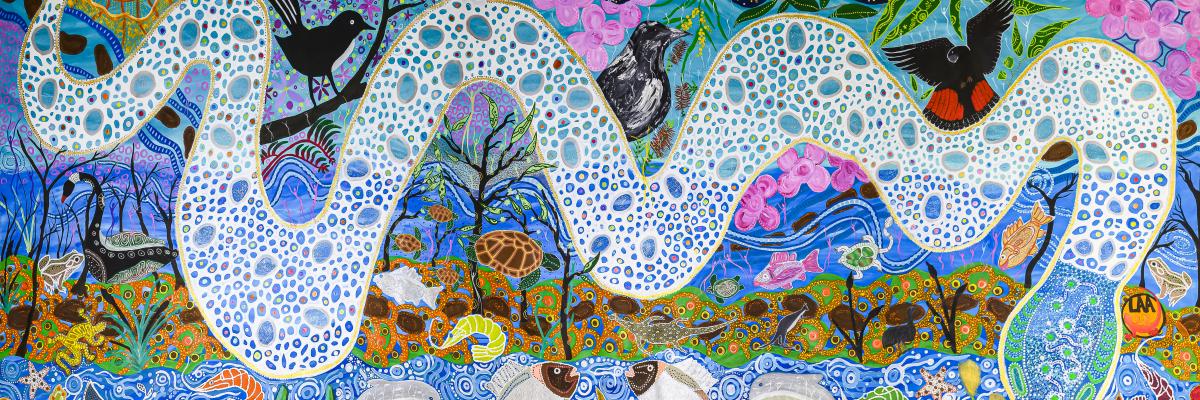Maladjiny-ap (Place of Growing)
Maladjiny-ap (Place of Growing) celebrates the Aboriginal culture and history of the area now known as the City of Gosnells.
The exhibition is on display in the Orange Room at the Gosnells Library, 2232 Albany Hwy, Gosnells from July 2024.
The artworks which make up this exhibition have been created by the participants and coordinators of the Langford Aboriginal Association's My Time and Art & Yarning groups, their handprints are below and form part of the exhibition in the Orange Room,
The City of Gosnells acknowledges the Whadjuk Noongar people who are the traditional custodians of this land. We pay our respect to their culture, history and their Elders past and present.
Heart of Our Community
Langford Aboriginal Association Inc
In the late 1990's, Aboriginal community members believed there weren't enough services within the City of Gosnells for Aboriginal people, so the Langford Aboriginal Association (LAA) was formed.
The organisation operates primarily on grant funding and has grown slowly over time to be a stronger and more sustainable incorporated association. In 2023, there were 12 staff and many volunteers.
The LAA Centre, on Imber Turn in Langford, has been developed into a functional and attractive space with program rooms, a commercial kitchen, a community and bush tucker garden and an open fire pit, providing a comfortable place for the community visit.
LAA runs many programs, some in partnership with other organisations. There are programs suitable for all age groups and they are free to attend. The well-attended programs are delivered at the Centre, which is easily accessible.
If LAA wasn't here, I don't think we'd know each other as well as we do. We really do just feel like one big family, which is how it used to be.
- Langford Aboriginal Association member
LAA has many plans for its future and is looking to become more of a cultural centre, incorporating Noongar language and culture. The Association has been built on a solid foundation and many moorditj (excellent) community members will continue to be part of the organisation far into the future.
For more information on the Langford Aboriginal Association visit their website.
Ngalang Moolyakiny
Our Beginnings
As Aboriginal people we always honour our great Wagyl as we travel on country, connected through spirit, working together to ensure the survival of country and culture
- Langford Aboriginal Association
The great Waygl (Rainbow Serpent) travelled down from the sky during the nyitting (creation time), creating the bilyas (rivers) and the birls (lakes) on our boodja (land/country), interconnecting our waterways, opening the valleys and the hills, connecting boodja and wardarn (ocean).
As the Wagyl journeys through the boodja and waterways, animal life begins. Within the waterways the creation of life begins, from the yaakin (freshwater turtles) to the maali (black swan), djildjit (fish), kwilena (dolphins), bamba (stingray) and the kooboolong (frogs).
On boodja life begins for the land animals, from the wetj (emu) to the yongka (kangaroo), the noorn (snakes), the kaarda (goanna), and all the other land animals. Sitting among our trees are the karak (red-tailed black cockatoo), koolbardi (magpie) and djidi-djidi (willy wagtail).
This is also a time for our many native flora like the kalyang (wattle), the Geraldton wax and nolamara (Kangaroo Paw) all sharing our boodja. As Aboriginal people we always honour our great Wagyl as we travel on country, connected through spirit, working together to ensure the survival of country and culture.
The bright colours used throughout represent the connection with the dreamtime story of the Wagyl.
Nakolak Moort Boodja
(Culture/Knowledge, Family, Country)
As Aboriginal people we cannot separate nakolak (culture/knowledge), moort (family) and boodja (country). These are three things that make us who we are and give us a sense of belonging and pride. This piece combines all three in a triptych, uniting them under one banner while also reflecting each individually.
Keeping connected to our nakolak, moort and boodja helps us to be resilient and strong warriors. It gives us a sense of pride and belonging. It is who we are.
- Langford Aboriginal Association.
The large tree in the centre which branches out represents moort. It's the Family Tree with its roots firmly grounded. The tree's roots show connection to our ancestors, our heritage and our history - boodja and nakolak all in one. It is where we come from, who we are, where we belong and how we are connected to boodja.
Each circle represents different moort, and the roots show the connection with flowing water. It runs through the tree roots representing life and reflecting growth running all the way up into the branches in the family tree. The trunk of the family tree reflects the knowledge that is held and passed on, when the time is right, to the next generations.
The branching out and flowing of the leaves over into boodja and nakolak represent the next generation growing up and having the knowledge passed on to them so they too can keep passing it down from one generation to the next. It reflects growth, strength and pride, and is the next generation keeping nakolak strong. The branches stretch out and over onto boodja and nakolak, bringing everything together along with the roots of the tree, making nakolak, boodja and moort one.
Moort circles at the bottom connect to the roots, with the leaves of the tree branching out and overlapping into nakolak and boodja as the new generations grow up. They are taught their moort history and all about their boodja and how they are connected to it from their moort - no matter where they go, far and wide, they are always connected to that boodja and its rich nakolak.
Boodja is represented throughout the painting with rolling hills, which also represent the songlines that are passed on from one generation to another. The community has left a thumb print on this section to represent different moort and connection to nakolak and boodja. Coming from different places on boodja they share their knowledge about moort, boodja and cultural connections, plants, animals, tracks, tools and figures, all representing parts of nakolak - hunting, gathering and dancing. The pink and purple represent the Women's meeting places, sacred sites, the blue and green are the Men's. Fire is represented as it is an important part of nakolak. It is used for healing cleansing with smoke. It is a place to gather for yarning, eating, sharing as well as for warmth and taking care of boodja.
Spirit faces have been placed in the stumps of the two outer trees. These represent our ancestors who look over us and our boodja. They protect our moort and give us direction on how to look after our boodja and keep our nakolak strong. They remind us to never forget our moort connections and to keep passing on our knowledge to the next generation. To always look after and stay connected to boodja by visiting boodja, practising nakolak and sharing stories, song lines, dance with moort, generation after generation, keeping our traditions alive.
We often like to meet under a shady tree and yarn. This is a place for moort to gather and share stories and knowledge. It is a place to gather and enjoy each other's company. A meeting place for all, big and small, for good times or bad times. This is represented by the meeting place under the central tree showing moort coming together. The meeting place and the tree have blue throughout which represents water, an essential part of life for everyone and everything. It is needed to encourage growth and helps heal the mind, body and spirit. It flows through the boodja and brings the flora and fauna to life, allowing hunting and gathering to happen throughout the different seasons. It is the giver of life. Keeping connected to our nakolak, moort and boodja helps us to be resilient and strong warriors, it gives us a sense of pride and belonging. It is who we are.
Maar-Keyn Bonar
The Six Seasons
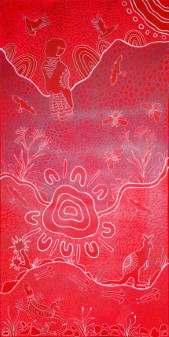 BIRAK (First Summer) - December - January
BIRAK (First Summer) - December - January
Season of the young
The last rains of Kambarang ease and the warm weather arrives. Sea breezes from the south-west provide relief from afternoon heat. This is fire season - the time when the country was burned in mosaic patterns to make it easier to move across the land, to aid seed germination and to make more grazing land for animals. Fledglings are venturing out of their nests and tadpoles are transforming into frogs.
 BOONAROO (Second Summer) - February - March
BOONAROO (Second Summer) - February - March
Season of adolescence
Boonaroo is the hottest time of the year with very little rain, hot easterly winds and a cooling afternoon sea breeze. This is the time for living near
the coast or estuaries and rivers and for eating freshwater foods and seafood. Look out for the white flowers of the jarrah, marri and ghost gums.
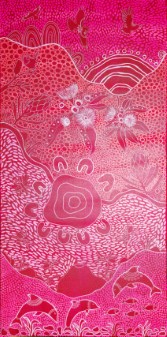 DJIRAN (Autumn) - April - May
DJIRAN (Autumn) - April - May
Season of adulthood
Djiran sees the break in the really hot weather with light breezes and dewy mornings. Fresh water fish, frogs and turtles, as well as root bulbs of yanget (bullrushes) and zamia seeds were common foods. As nights become cooler and damp, it is time to prepare for the coming Mookaroo, building and repairing mia-mias to make sure they are waterproofed in readiness for winter rains.
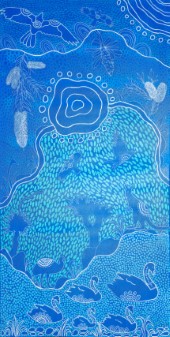
MOOKAROO (Winter) - June - July
Season of fertility
It is cold and wet during Mookaroo and time to move inland, away from the coast. Food changes from sea, river and lake foods to those from the land, like grazing animals yongar (kangaroo) which provide both meat and bookas (cloaks for the cold weather). Animals pair up in preparation for breeding. Flowers during Mookaroo are blue and purple tending to white and cream as Djilba approaches.
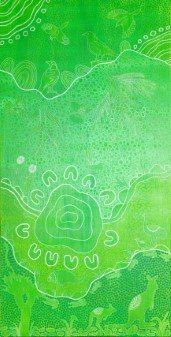
DJILBA (First Spring) - August - September
Season of conception
Cold, clear days combine with warmer, wet and windy days. Food continues to be from the land and includes yongar (kangaroo), waitj (emu) and koomal (possum). There an an abundance of flowers blooming, starting with yellow acacia, and newborns begin to appear. Koolbardi (magpies)
and djidi-djidi (willy wag tails) are swooping to protect their babies.

KAMBARANG (Second Spring) - October - November
Season of birth
Kambarang is a time of warmer, drier weather. The abundance of colours and flowers continues with the striking tall flower stalks of the balga
(grass trees) and the bright yellow/orange flowers of the moodja (Australian Christmas Tree) showing that the heat is on its way. Watch out for snakes and other reptiles making the most of the warming weather.
Disclaimer: the Noongar language, like all traditional languages in Australia, is an oral language. Please be aware that there are different ways to spell many words, including Noongar.
